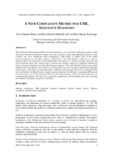A New Complexity Metric for UML Sequence Diagrams

View/
Date
2023-01Author
Maina, Nevy K.
Muketha, Geoffrey M.
Wambugu, Geoffrey M.
Metadata
Show full item recordAbstract
Object-Oriented Programming (OOP) has been promoted as a way to produce high-quality software while increasing developer productivity through code reuse. Software systems and underlying designs get more extensive and more complicated while maintaining a high degree of quality. One of the widely accepted standards for describing software architectures is the UML Sequence Diagram. A sequence diagram depicts the interaction of two-dimensional chart players by showing messages delivered and received between them. This research aims to develop and validate a metric for complexity evaluation in software design architectures through UML Sequence diagrams. The study included design science, which included metric specification, the creation of a measurement tool, and conceptual and factual verification of the metrics. The metrics use diagram-centric complexity measurements shown to be meaningful when used to determine the difficulty of two example sequence diagrams. Furthermore, conceptual affirmation of the stated metrics was achieved through Weyuker's nine characteristics, which demonstrated that they are computationally efficient. The metric was empirically authenticated, and the findings show that measuring the complexity of sequence diagrams is expedient.
Collections
- Journal Articles (CI) [141]
